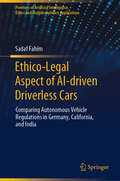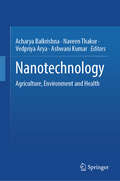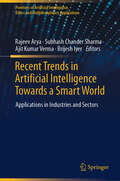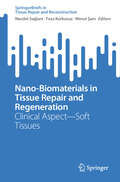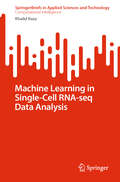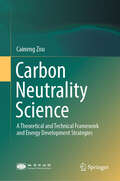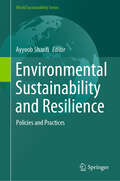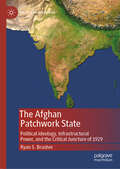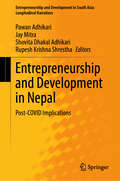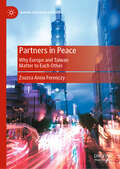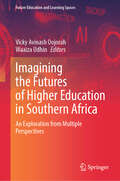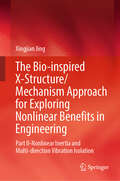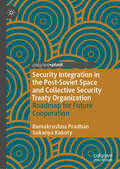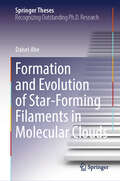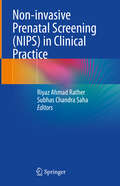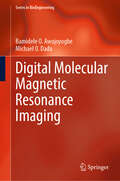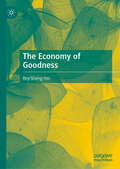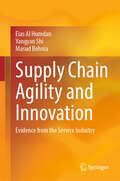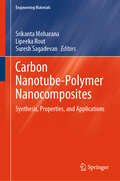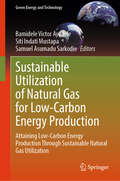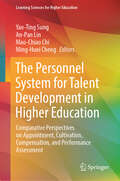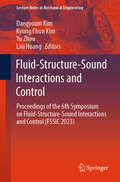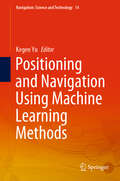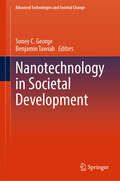- Table View
- List View
The Aesthetic Thought and View of Art of Thomas Aquinas
by Zhiqing ZhangThis book examines Aquinas's aesthetic thought and view of art within the broader context of medieval aesthetics and the history of aesthetic development, emphasizing its profound influence on later aesthetics. The book not only elaborates on Aquinas's efforts to establish coherence between faith and reason, the transcendent and empirical, as well as its significance, but also discusses the main contents and characteristics of Aquinas's aesthetic thought from the three aspects of the ontology of beauty, the theory of form, and the theory of experience. By examining Aquinas's aesthetic thought and view of art in relation to modern aesthetics and twentieth-century aesthetics, this book reveals the immense vitality of Aquinas's aesthetic thought.
Ethico-Legal Aspect of AI-driven Driverless Cars: Comparing Autonomous Vehicle Regulations in Germany, California, and India (Frontiers of Artificial Intelligence, Ethics and Multidisciplinary Applications)
by Sadaf FahimThis book is a comparative study of the laws and regulations involving legal and ethical issues related to Artificial Intelligence (AI), in particular for self-driving cars or autonomous vehicles (AVs). It identifies, analyzes, and points out such issues via a study of laws and regulations in India, Germany, and California, determining the legal liabilities of designer, developer/programmer, manufacturer, producer, users, or AI in the case of AVs. AV technology is being touted as one that is poised to bring revolution in the mobility ecosystem by lessening the number of accidents and by providing other benefits, such as potential to reduce traffic, increase safety and mobility, lower energy usage and generate free time. Despite having such a potential to shape and transform the future, and involvement of tech-giants like Google, Amazon, Facebook, and Microsoft, regulations around AI and AVs are still on the drawing board stage in many countries, as they grapple on how to address this issue which has both local and global players involved and affects both local and global populace. The book studies and compares the existing and evolving regulations in three different regions to bring out the lacunae, loopholes and best practices. It highlights when AI deserves legal personhood, and when it requires to be granted legal standing. It also points out the civil and criminal legal liabilities arising when AV is involved in an accident, and the ethical issues involved in the deployment of AI. The book goes beyond new regulations to analyze whether challenges and problems arising from AI technology can be addressed within existing civil and criminal laws - procedural and substantive law – or whether a sui generis law on AI technology is required. The analysis and the results showcased here would be highly useful for multi-disciplinary research on the topic. Regulators of both industry and governance would find the contents invaluable in getting a broader picture of the issues and concerns around this topic, along with policy makers would be able to come up with more effective regulations on AI and AVs.
Nanotechnology: Agriculture, Environment and Health
by Acharya Balkrishna Naveen Thakur Vedpriya Arya Ashwani KumarThis book presents an update on the state of the art in nanobiology and various nanoparticle synthesis and characterization methods. Further, the application of nanomaterials in agriculture (nanobiofertilizers and nanobiopesticides), environmental remediation (bio-nanoaugmentation), and public health (diagnosis, treatment, and drug delivery) is also a key area of this book. This book serves as a roadmap for researchers to fill various gaps by designing and organizing future research. It offers a crucial reference for academic researchers in nanotechnology, medicine, material science, toxicology, agriculture, environmental science, and biomedical science.
Recent Trends in Artificial Intelligence Towards a Smart World: Applications in Industries and Sectors (Frontiers of Artificial Intelligence, Ethics and Multidisciplinary Applications)
by Ajit Kumar Verma Brijesh Iyer Rajeev Arya Subhash Chander SharmaThis book compiles artificial intelligence (AI) applications in new communication technologies such as the cognitive radio networks, internet of things (IoT), internet of drones (IoD), internet of vehicles (IoV), and autonomous underwater vehicles (AUV), which are expected to increase the amount of data traffic. Recognizing that AI is revolutionizing industries with its applications and helping us solve complex problems with ease, the book tackles a variety of industries and sectors such as agriculture, logistics, infrastructure, manufacturing, education, disaster management, transport, surveillance, and more. Contributions included in the book are useful for students, engineers (disciplines like telecommunication, mechanical and computer science, etc.), teachers, people studying and working for strategic, tactical and operational management. It is also useful for data scientists and anyone else who wants to have an insight into the impact of artificial intelligence on various industries. Due to its focus on healthcare and agriculture, the horizon of the book is enhanced to include healthcare industry personnels and agriculture sector. Additionally, it provides guidance for government personnel who are working towards system upgradation for managing dynamic traffic demands.
Nano-Biomaterials in Tissue Repair and Regeneration: Clinical Aspect—Soft Tissues (Tissue Repair and Reconstruction)
by Necdet Sağlam Feza Korkusuz Mesut ŞamThis book covers the clinical application of nano-bio-materials in hard tissue repair and regeneration which are materials designed to interact with biological systems to restore and regenerate damaged tissues. These materials serve as scaffolds that mimic the natural extracellular matrix (ECM), providing structural support and biochemical cues necessary for cellular activities. The physical and chemical properties of biomaterials can be tailored to specific applications, such as bone regeneration, cartilage repair, wound healing, and organ transplantation. Biomaterials influence cell behavior and tissue formation by controlling factors like mechanical strength, porosity, and surface topography. This book is suitable for students, academics, and clinical practitioners who are interested in the advancements of regenerative medicine.
Machine Learning in Single-Cell RNA-seq Data Analysis (SpringerBriefs in Applied Sciences and Technology)
by Khalid RazaThis book provides a concise guide tailored for researchers, bioinformaticians, and enthusiasts eager to unravel the mysteries hidden within single-cell RNA sequencing (scRNA-seq) data using cutting-edge machine learning techniques. The advent of scRNA-seq technology has revolutionized our understanding of cellular diversity and function, offering unprecedented insights into the intricate tapestry of gene expression at the single-cell level. However, the deluge of data generated by these experiments presents a formidable challenge, demanding advanced analytical tools, methodologies, and skills for meaningful interpretation. This book bridges the gap between traditional bioinformatics and the evolving landscape of machine learning. Authored by seasoned experts at the intersection of genomics and artificial intelligence, this book serves as a roadmap for leveraging machine learning algorithms to extract meaningful patterns and uncover hidden biological insights within scRNA-seq datasets.
Carbon Neutrality Science: A Theoretical and Technical Framework and Energy Development Strategies
by Caineng ZouThis book focuses on the connotation and extension of carbon neutrality. It presents a full collection of various topics in carbon neutrality, including carbon production, reduction, utilization, storage, capture, markets, and society, etc. It concludes that carbon neutrality is the pathway to global green and low-carbon sustainable development and the foundation for building harmonious ecological civilization. This book is a valuable reference for researchers, practitioners, and policy-makers in the field of earth and environmental sciences.
Environmental Sustainability and Resilience: Policies and Practices (World Sustainability Series)
by Ayyoob SharifiThis volume offers a comprehensive exploration of the environmental challenges and innovations shaping our world. It represents a collective effort to understand and address the pressing issues that define our era, from climate change to resource management. Through a series of expert contributions, it examines the intricate relationship between human activity and the environment, seeking pathways to a more sustainable and just future. The insights presented are crucial for anyone looking to contribute to the global pursuit of Sustainable Development Goals. This volume is an invaluable resource for policymakers, researchers, educators, students, and activists alike; offering a well-rounded perspective on the multifaceted aspects of environmental sustainability - it's both a call to collective action as well as reminder urging us all—to rethink our strategies collaboratively towards achieving healthier world and more resilient planet.
The Afghan Patchwork State: Political Ideology, Infrastructural Power, and the Critical Juncture of 1929 (Politics of South Asia)
by Ryan S. BrasherThis book provides a theoretically grounded and empirically fine-grained analysis of uneven state development in Afghanistan beginning in the early 20th Century. Based on archival research, the book shows that after Amanullah Shah’s abortive modernist authoritarian experiment and Habibullah Kalakani’s brief rule, a newly empowered Musahiban dynasty charted a patrimonial absolutist course. The new regime delegated considerable authority to traditional tribal areas in the southeastern and eastern part of the country, while pursuing a coercive strategy in other parts of the country that usurped traditional leadership at the regional and local levels. Previous explanations of the weakness of the Afghan state tend to emphasize structural determinants such as difficult geography, acephalous tribal organization, ethnic heterogeneity, as well as colonial interventions. Others have focused only on events after the Soviet or NATO interventions, pointing out faulty external decision-making, corrupt government officials and warlords, neighboring insurgent safe havens, or the international aid-fueled rentier economy. This book proposes an intermediate explanation for the patchwork nature of the Afghan state rooted in institutional choices made by a new ruling elite that took over in 1929. The year represents one critical juncture in Afghan history, where individual agency based on certain ideological preferences set in motion a path-dependent process that shaped its politics well into the latter half of the century.
Entrepreneurship and Development in Nepal: Post-COVID Implications (Entrepreneurship and Development in South Asia: Longitudinal Narratives)
by Pawan Adhikari Jay Mitra Shovita Dhakal Adhikari Rupesh Krishna ShresthaThis book illustrates a connection between entrepreneurship and development in an emerging economy context, focusing on Nepal. That entrepreneurship contributes to sustainable development by creating jobs, elevating economic growth, promoting innovation, and mitigating social and environmental challenges is discussed in other works. Entrepreneurship is linked to several sustainable development goals. However, relatively little is known about entrepreneurship in Nepal at an international level and rarely have researchers attempted to explore the relationship between entrepreneurship and development in the Nepalese context. In this regard, this book generates valuable insights, not only contributing to policy implications but also setting a direction for entrepreneurship research in Nepal within a wider context of sustainable development. In particular, the book discusses several important issues on entrepreneurship, including migrant entrepreneurship, entrepreneurial ecosystem, social entrepreneurship, entrepreneurial finance, community-based entrepreneurship, and tourism entrepreneurship, issues which are intrinsically connected to the sustainable development of the country. In addition to policy contributions, the book provides a direction for facilitating theoretically underpinned work in entrepreneurship and development in the Nepalese context. The factors driving entrepreneurship, including specific social-cultural and historical factors that remain relevant for emerging economies, and emancipation, inclusion and participation, which are central to achieving development, are to be theorized in order to better understand the relationship between entrepreneurship and development. The topics covered by the book will be of interest to policy-makers from ministries and departments, international organizations, and development partners.
Partners in Peace: Why Europe and Taiwan Matter to Each Other (Taiwan and World Affairs)
by Zsuzsa Anna FerenczyThis book addresses the following fundamental questions: With the EU seeing Taiwan as a partner on its own merit (rather than exclusively through the China factor lens), how can the two sides consolidate this new normal, what next? How can they expand cooperation in a way that both increases the EU’s role in shaping Taiwan’s future and empowers Taiwan to exercise agency? Taiwan’s geo-strategic relevance is likely to grow in the Indo-Pacific, a region of great significance to the EU’s own interests. Protecting these will require a more engaged Europe. In this trenchant and engaging volume, Dr. Ferenczy explores what European policy towards the Asian hotspot should be, of interest to policymakers, scholars and journalists.
Imagining the Futures of Higher Education in Southern Africa: An Exploration from Multiple Perspectives (Future Education and Learning Spaces)
by Waaiza Udhin Vicky Avinash OojorahThis book showcases multiple perspectives about the futures of Higher Education from experts and other stakeholders in academia in the Southern African region, with each chapter presenting a different scenario of a possible future for Higher Education. It situates itself at the confluence of various fields of study such as Educational Technologies, Artificial Intelligence (AI), Sociology of Education, Sociology of the Future, Sustainable Development and Climate Change. It also includes various topics, such as digital development in terms of AI and emerging technologies, Higher Educational strategising and planning, the philosophical underpinnings of Higher Education and the present-day need for Sustainable Development models. Through the various chapters discussing the above-mentioned themes in the varied contexts of the Southern African region, this book helps readers engage in imaginative thinking regarding the future world and thus be prepared to embrace the challenges ahead. This book also underpins curriculum development for the new era firstly through new philosophical outlooks and secondly through ideas for novel learning areas in Higher Education and content to help shape minds for the twenty-first century. This book paves the way for innovation, progress and adaptation to the changing needs of the Higher Education clientele. It also attempts to influence policymaking, support advocates for sustainability and environmental education, prepare for technological advancements and improve the resilience and wellbeing of people in the region.
The Bio-inspired X-Structure/Mechanism Approach for Exploring Nonlinear Benefits in Engineering: Part II-Nonlinear Inertia and Multi-direction Vibration Isolation
by Xingjian JingThis book presents a unique approach to the design and analysis of beneficial nonlinearity, which can take an important and critical role in engineering systems and thus cannot be simply ignored in structural design, dynamic response analysis, and parameter selection. A key issue in the area is thus systematically addressed about how to analyze and design potential nonlinearities introduced to or inherent in a system of under study, which is a must-do task in many practical applications involving vibration control, energy harvesting, sensor systems and robots, etc. This book, therefore, presents an up-to-date summary on the most recent development of a cutting-edge method for nonlinearity manipulation and employment developed in recent several years, named as the X-shaped structure or mechanism approach. The method is inspired from animal leg/limb skeletons and can provide passive low-cost high-efficiency adjustable and beneficial nonlinear stiffness (high static and ultra-low dynamic), nonlinear damping (dependent on resonant frequency and vibration excitation amplitude) and nonlinear inertia (low static and high dynamic) individually or simultaneously. The X-shaped structure or mechanism is a generic structure or mechanism representing a class of beneficial geometric nonlinearity with realizable and flexible linkage mechanism or structural design of different variants or forms (quadrilateral, diamond, polygon, K/Z/S/V-shape, or others) which all share similar geometric nonlinearity and thus similar nonlinear stiffness/damping properties, flexible in design, and easy to implement. This book systematically reviews the research background, motivation, essential bio-inspired ideas, advantages of this novel method, beneficial nonlinear properties in stiffness, damping and inertia, and potential applications, which have been developed ever since 2010. This book reveals important nonlinear properties and dynamic characteristics of nonlinear inertia that can be provided through the X-structure/mechanism and also presents advantageous features of X-structure/mechanism methods in multi-direction vibration control.
Security Integration in the Post-Soviet Space and Collective Security Treaty Organization: Roadmap for Future Cooperation
by Ramakrushna Pradhan Sukanya KakotyThis book explores the role of the Central Security Council (CSTO) in ensuring regional security, analyzing the evolution of cooperation between post-Soviet states since the Soviet Union's demise. It focuses on the establishment of the CSTO as a regional organization since 2002, with six out of 11 CIS members. The book fills a gap in existing research on the security paradigm in post-Soviet space and the collective security mechanism of CSTO. Many western scholars have not understood the importance of multilateralism and Russia's foreign policy in maintaining security measures in the post-Soviet space. The book is an informative handbook on regional integration, Eurasianism, and CSTO for students, scholars, readers, academicians, and researchers working on this area.
Formation and Evolution of Star-Forming Filaments in Molecular Clouds (Springer Theses)
by Daisei AbeThis book clears up some confusion in the field of star formation and proposes a solution to a problem that remains unsolved for more than a decade. Observations of molecular clouds show that dense filaments are the sites of present-day star formation, and it is thus necessary to understand the filament formation process because the filament is an initial condition in a star formation process. Theoretical studies suggest that shock waves in molecular clouds trigger filament formation. Several different mechanisms have been proposed, and the formation mechanism of the observed star-forming filaments is expected to be clarified. In this book, the author performs a series of isothermal magnetohydrodynamics (MHD) simulations of filament formation and identifies the formation mechanisms. It is found that the dominant filament formation mode changes with the velocity of the shock waves that trigger the filament formation. The filament width plays an important role in determining the fragmentation scale by self-gravity, and observations show that the width 0.1 pc is universal. On the other hand, in theory the width of the supercritical filaments was considered to be narrowed by self-gravity. Recent studies suggest that massive filaments are bound by the slow shocks that are caused by accretion flows onto the filaments. Since the wavefront of such a slow shock is known to be unstable as a slow shock instability (SSI), the accretion ram pressure is expected to be converted into thermal/turbulent pressure across the shock front, which potentially maintains the width. In the scale of dense filaments, ambipolar diffusion (AD) suppresses the SSI at small scales. The influence of AD on SSI is investigated using two-dimensional MHD simulations, and the nonlinear evolution of the SSI with AD is found to drive turbulences. The book demonstrate the effect of SSI including AD onto the filament evolution.
Non-invasive Prenatal Screening (NIPS) in Clinical Practice
by Riyaz Ahmad Rather Subhas Chandra SahaThe book provides a comprehensive overview of the use of non-invasive prenatal screening (NIPS) in clinical practice. It covers advanced genomic approaches and operational strategies related to NIPS. It aims to fill a gap by offering a thorough historical background and genesis of NIPS technology, including its methodology, clinical utility, challenges, and future directions. The book is divided into three sections: Section I discusses the advent of NIPS, Section II addresses detection strategies and clinical implementation, and Section III explores the challenges and prospects of NIPS technology. The book benefits specialists who practice prenatal medicine as well as reproductive specialists, genetic councilors, research scholars and postgraduate medical students of obstetrics and gynecology.
Digital Molecular Magnetic Resonance Imaging (Series in BioEngineering)
by Michael O. Dada Bamidele O. AwojoyogbeThis book pushes the limits of conventional MRI visualization methods by completely changing the medical imaging landscape and leads to innovations that will help patients and healthcare providers alike. It enhances the capabilities of MRI anatomical visualization to a level that has never before been possible for researchers and clinicians. The computational and digital algorithms developed can enable a more thorough understanding of the intricate structures found within the human body, surpassing the constraints of traditional 2D methods. The Physics-informed Neural Networks as presented can enhance three-dimensional rendering for deeper understanding of the spatial relationships and subtle abnormalities of anatomical features and sets the stage for upcoming advancements that could impact a wider range of digital heath modalities. This book opens the door to ultra-powerful digital molecular MRI powered by quantum computing that can perform calculations that would take supercomputers millions of years.
The Economy of Goodness
by Rey-Sheng HerThis book, "The Economy of Goodness" by Dr. Rey-Sheng Her, offers a comprehensive faith-based and philosophical perspective on economic activities throughout human history. It explores how cross-cultural ethics and philosophies, particularly Eastern and Western, shape our economy. The book delves into applying altruism to economic spheres, demonstrating how good motivations and means lead to good outcomes. Key themes include defining 'goodness' as altruism, harmony, and common goodness, and addressing fairness and justice in production, consumption, trade, and finance. Highlighting enterprises that embody these ideals, the book also presents ten principles for fostering altruistic business practices, aiming to guide society toward common wealth and goodness. This engaging and insightful work is essential for those interested in economics, ethics, and the philosophy of altruism.
Supply Chain Agility and Innovation: Evidence from the Service Industry
by Eias Al Humdan Yangyan Shi Masud BehniaThis book critically examines the concept of 'supply chain agility' (SCA) in a novel context, shedding light on its implications for executives and professionals. While much literature has explored SCA in manufacturing, this book pioneers a comprehensive exploration of its application in the service sector, an often-overlooked domain in operations management, supply chain management, and innovation literature. The analysis, based on data from 245 service firms in Australia, employs a unique approach, revealing a positive relationship between firm innovativeness and SCA, with SCA in turn positively impacting firm performance. By bridging gaps in previous research, this book offers conceptual, methodological, and empirical contributions, emphasizing the critical role of innovation in achieving SCA, particularly in uncertain contexts. It provides valuable insights for firms navigating the service economy, offering a holistic examination of the benefits of SCA and empirically validating its role in managing market changes cost-effectively for a competitive advantage. The findings encourage a re-evaluation of firm performance, urging business professionals and managers to adopt a comprehensive perspective. The insights presented serve as a valuable tool for measurement, estimation, assessment, and benchmarking—key drivers for improving and predicting performance in dynamic supply chain environments. Overall, this book is a timely and essential resource for those seeking to understand and enhance supply chain agility in the evolving landscape of the service industry.
Carbon Nanotube-Polymer Nanocomposites: Synthesis, Properties, and Applications (Engineering Materials)
by Suresh Sagadevan Srikanta Moharana Lipeeka RoutThis book presents the latest advancements in various synthetic techniques, properties, characterization, and efficient applications of CNT-polymer nanocomposites. The preparation, properties, characterization, and applications of these technologically intriguing new materials are discussed in detail. The book covers a wide range of topics from the fundamentals of carbon nanotubes, their reinforced polymer nanocomposites and their applications in various fields including energy storage, 3D printing, electronics, aerospace and coatings, and environmental and bio-medical/bioengineering. It is a good resource for students, material scientists, and professionals interested in the synthesis, properties, characteristics, and cutting-edge applications of carbon nanotubes-polymer nanocomposites.
Sustainable Utilization of Natural Gas for Low-Carbon Energy Production: Attaining Low-Carbon Energy Production Through Sustainable Natural Gas Utilization (Green Energy and Technology)
by Bamidele Victor Ayodele Siti Indati Mustapa Samuel Asumadu SarkodieThis book presents a detailed analysis of sustainable utilization of natural gas for low-carbon energy production. Its content is divided into three parts with the intention to address natural gas supply chain, technological advances in natural gas utilization, and role of natural gas in transition to a low-carbon economy. In particular, it describes the various technological pathways for the conversion of natural gas to valuable products such as hydrogen, syngas and other alternative fuel, which can be used as chemical intermediates or for co-generation of electricity and heat. This book is targeted at wide audience in the academia and industries who want a comprehensive knowledge of how natural gas can be sustainable utilized for low-carbon energy production.
The Personnel System for Talent Development in Higher Education: Comparative Perspectives on Appointment, Cultivation, Compensation, and Performance Assessment (Learning Sciences for Higher Education)
by Ming-Huei Cheng Yao-Ting Sung An-Pan Lin Mao-Chiao ChiThis book explores innovative talent development models to improve the quality of university education and long-term human resource development. Additionally, it investigates factors and issues that affect the effectiveness of faculty appointments, compensation, cultivation, retention, and performance assessment. The book is a useful resource for scholars and researchers in the field of comparative higher education, administrators and stakeholders in education management, and graduate students majoring in higher education. Ultimately, it assists education leaders, policymakers, and human resources practitioners in establishing a strategic personnel system for talent development.
Fluid-Structure-Sound Interactions and Control: Proceedings of the 6th Symposium on Fluid-Structure-Sound Interactions and Control (FSSIC 2023) (Lecture Notes in Mechanical Engineering)
by Yu Zhou Lixi Huang Daegyoum Kim Kyung Chun KimThis proceedings book focuses on advances in theory, experiments and numerical simulations of fluid-structure-sound interactions related to turbulence, flow-induced vibration, noise and their control. This includes important practical areas of interaction such as vehicle aerodynamics, marine and civil engineering, nuclear reactors and biomedicine. One of the special features of this book is that it integrates new emerging fields with the study of fluid-structure-sound interactions, which is not common practice but scientifically very helpful in understanding, simulating and controlling fluid-structure-sound interaction systems. This provides a broader view of the discipline from which readers will benefit greatly.
Positioning and Navigation Using Machine Learning Methods (Navigation: Science and Technology #14)
by Kegen YuThis is the first book completely dedicated to positioning and navigation using machine learning methods. It deals with ground, aerial, and space positioning and navigation for pedestrians, vehicles, UAVs, and LEO satellites. Most of the major machine learning methods are utilized, including supervised learning, unsupervised learning, deep learning, and reinforcement learning. The book presents both fundamentals and in-depth studies as well as practical examples in positioning and navigation. Extensive data processing and experimental results are provided in the major chapters through conducting experimental campaigns or using in-situ measurements.
Nanotechnology in Societal Development (Advanced Technologies and Societal Change)
by Soney C. George Benjamin TawiahThis book investigates the complex effects of nanotechnology across numerous fields such as nanomedicine, tailored therapy in medicine and health care, transformational treatment choices for various illnesses, electronics, and computing via miniaturization. In addition, the contributions of nanotechnology to quantum computing, and flexible electronics has been examined. More so, the book discusses the advantages of nanotechnology in the energy and environmental sectors, such as solar cells, energy storage systems, and water purification technologies, in order to solve major global concerns. The impact of nanotechnology on materials and production processes, with applications in construction, aerospace, and other fields, is highlighted. The book further discusses the ethical and societal issues such as safety, privacy, equal access, and thoroughly examined how to strike a balance between innovation and responsible development of nanotechnology in the context of stringent rules and proactive risk assessment. Furthermore, the ability of nanotechnology to bridge the technological divide in underdeveloped nations while minimizing environmental implications is also highlighted.

